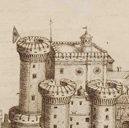0271 Francisco de Holanda's Drawings and Words: Fortification, Architecture and Urban Design
Identifiers (Article)
Abstract
Artistically gifted courtier Francisco de Holanda (1517/1518–1584) left several manuscripts, containing both texts and drawings, in a quantity and of a consistency rarely seen in sixteenth-century Portugal. Holanda's contributions to architectural knowledge are well known among scholars, yet their relevance has not been fully acknowledged. Some obstacles need to be overcome: a one-sided disciplinary approach, a disproportionate focus on the influence of treatises, and the seductive pull of an eccentric personality. Beyond the debate on his contribution to artistic practice or even to the idea of classical antiquity, his achievements had a bearing on Portuguese culture in a wider and more complex sense than has previously been discussed. Educated in royal circles, at a time when imperial overseas ambitions depended strongly on military expertise, Holanda lent his skills as a painter to the task of espionage through his drawings of foreign fortifications, while making a significant contribution to the development of architectural language and thus to the emergence of the architect's profile. As such, a reassessment of the legacy of this artistically talented courtier is long overdue. Rereading his works and putting all the pieces together gives us a better insight into the bonds between art theory and architecture, fortification and urban design, from the position of a cultured non-specialist.
Statistics


Published (Versions)
- 2022-05-03 (2)
- 2022-03-30 (1)
License

This work is licensed under a Creative Commons Attribution-NonCommercial-NoDerivatives 4.0 International License.



